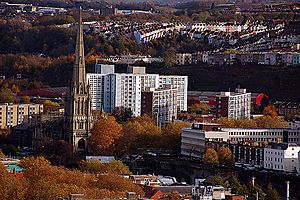Redcliffe, Bristol facts for kids
Quick facts for kids Redcliffe |
|
|---|---|
| OS grid reference | ST 591 722 |
| Unitary authority | |
| Ceremonial county | |
| Region | |
| Country | England |
| Sovereign state | United Kingdom |
| Post town | BRISTOL |
| Postcode district | BS |
| Dialling code | 0117 |
| Police | Avon and Somerset |
| Fire | Avon |
| Ambulance | Great Western |
| EU Parliament | South West England |
| UK Parliament |
|
Redcliffe, sometimes called Redcliff, is a cool area in the port city of Bristol, England. It's located just southeast of the city centre. This district is surrounded by water! To the west, north, and east, you'll find the Floating Harbour, which includes Bathurst Basin. To the south, it's bordered by the New Cut, a channel of the River Avon.
Most of Redcliffe is part of the Lawrence Hill city ward. However, the far western part, where the famous cliffs are, belongs to Cabot ward. You'll also find Bristol Temple Meads station, a major train station, right here in Redcliffe.
Redcliffe gets its name from the amazing red sandstone cliffs. These cliffs line the southern side of the Floating Harbour, near Phoenix Wharf and Redcliffe Wharf. The cliffs are full of tunnels, known as the Redcliffe Caves. These tunnels were dug to get sand for making glass and to store goods. You can even see part of an old glass oven, called a kiln, which is now part of the Ramada Bristol City Hotel.
The local church, St. Mary Redcliffe, is one of Bristol's most famous buildings. Its spire reaches 292 feet (90 meters) high, making it the second tallest building in the city!
Contents
A Look at Redcliffe's Past
Redcliffe was originally part of a larger area called Bedminster. It was separated from Bristol by the River Avon. The deep water next to the red sandstone cliffs, where St Mary Redcliffe church now stands, was perfect for building docks. Back then, people and merchants in Redcliffe and Bristol were often rivals! The only way to cross the river was by Bristol Bridge, though many small ferries also helped people get across.
In the 1100s, a man named Robert Fitzroy gave some land in Redcliffe to the Knights Templar. This area became known as Temple Fee. The Templars were powerful; they could even hold courts and punish criminals. Later, after the Templars were no longer active, these rights passed to the Knights of St. John of Jerusalem.
Early jobs in Redcliffe included weaving, fulling (cleaning and thickening cloth), and dyeing. These processes could be quite smelly! So, they were probably set up here, outside Bristol's city walls, where they wouldn't bother people inside the town.
How Redcliffe Grew
In the 1200s, Redcliffe and Bristol grew very quickly. During the time of King Henry III, a big project improved the harbour. This involved digging a 'Great Ditch' to create a new path for the River Frome. This made more space for ships to dock and new quays (loading areas) were built.
At the same time, a stone bridge, Bristol Bridge, was built. To do this, the River Avon was temporarily moved through Redcliffe. Strong stone foundations were laid for the bridge. King Henry III even asked "the men of Redcliffe" to help with these important projects.
About a hundred years later, in 1373, Redcliffe officially became part of Bristol. This was a big deal because Bristol was made a "city and county." This meant that legal problems no longer had to be taken to courts far away in places like Gloucester or Ilminster.
The Famous Shot Tower

In 1782, a clever inventor named William Watts turned his house near St Mary Redcliffe into the world's first shot tower. He used a special method to make lead shot (small pellets) by dropping melted lead from a great height.
The Redcliffe Shot Tower was a well-known landmark in Redcliffe for many years. However, it was taken down in 1968 to make way for new roads. The job of making shot then moved to the Cheese Lane Shot Tower, which is still on the banks of the Floating Harbour.
Important People from Redcliffe
- William II Canynges - a very important merchant (businessman) from Redcliffe.





